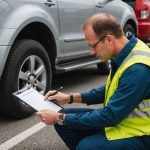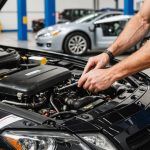In the realm of automotive safety, airbags have emerged as a pivotal component of protection for both drivers and passengers. These ingenious devices are meticulously engineered to mitigate the impact of crashes, potentially sparing countless lives each year. As responsible vehicle owners, it is imperative for you to ensure that your airbags are always ready to deploy when needed. This comprehensive guide is crafted to assist you in evaluating the functionality of your vehicle’s airbag systems, thus enhancing your overall safety on the road.
Understanding the Airbag System
Airbag systems are complex mechanisms comprising multiple components that work in tandem to provide optimal safety. At the forefront of this system are the sensors, sophisticated devices designed to detect a collision and trigger the deployment of the airbags.
Additional reading : What role does vehicle maintenance play in preventing accidents?
Key Components of an Airbag System
- Control Unit: This acts as the brain of the airbag system, receiving data from sensors and determining whether deployment is necessary.
- Sensors: These are strategically placed throughout the vehicle to detect sudden deceleration or impact.
- Airbags: Stored in various locations such as the steering wheel, dashboard, seat, and side panels, these are made from lightweight materials that inflate instantaneously upon activation.
- Inflators: These contain the chemical propellant necessary for the rapid inflation of the airbags.
Understanding how these components interact can help you gauge whether your airbags are in optimal condition. It’s vital to recognize that even a minor malfunction in one component can compromise the entire system, potentially leading to catastrophic outcomes during a crash.
Signs of Airbag Malfunction
Detecting a malfunction in your airbag system can sometimes be as simple as observing a few tell-tale signs. As vigilant stewards of your vehicle’s safety, you should be aware of the following indicators:
In the same genre : Essential Guide to Properly Verify Your Off-Road Vehicle”s Rear Differential Lock Functionality
Dashboard Warning Lights
One of the most obvious signs of an airbag issue is the illumination of the airbag light on your dashboard. This light can signal a range of issues, from sensor faults to wiring problems. If this indicator remains lit or begins flashing, it is crucial to have your vehicle assessed by a professional.
Physical Inspection
While not always apparent, inspecting the physical condition of your airbags can offer insights into their status. Look for any wear or damage on the covers where the airbags are stored. If they appear tampered with or exhibit signs of damage, further inspection is warranted.
Irregular Sensor Feedback
Modern vehicles often come equipped with complex sensor systems designed to ensure the airbags deploy correctly. If you notice irregularities in sensor feedback, such as the crash sensors not responding accurately, it’s a sign that your airbag system might require attention.
Professional Diagnostics
Despite the visual and sensory cues, the most reliable way to diagnose an airbag issue is through professional diagnostics. Automotive technicians possess the tools and expertise to delve into your vehicle’s electronic systems, ensuring that all components are functioning seamlessly.
Regular Maintenance: A Key to Airbag Safety
Routine maintenance plays a foundational role in ensuring the performance and reliability of your airbag system. Keeping your vehicle’s components in prime condition can not only extend the lifespan of your airbags but can also prevent unforeseen deployment failures.
Scheduled Inspections
Regular airbag inspections by certified professionals should be a staple in your vehicle maintenance regimen. These inspections can reveal potential issues, allowing you to address them before they escalate into serious safety hazards.
Updating Software
As technology evolves, so do the methods used to enhance vehicle safety systems. Keeping your vehicle’s software updated ensures that the airbag system operates with the latest protocols and is free from vulnerabilities.
Sensor Maintenance
Pay particular attention to the sensors, as they are integral to the airbag’s operation. Ensure they are clean, undamaged, and correctly calibrated to provide accurate data to the control unit.
Routine check-ups and maintenance can significantly reduce the risk of airbag system failures, providing peace of mind as you navigate the roads.
Advancements in Airbag Technology
Recent years have witnessed remarkable strides in airbag technology, resulting in enhanced safety features and more reliable systems. Staying informed about these advancements can help you make educated decisions about your vehicle’s airbag systems.
Multi-stage Deployment
Unlike traditional airbags that deploy with a single explosive burst, modern airbags utilize multi-stage deployment systems. These adjust the force of inflation based on the severity of the crash, offering a more tailored response to different collision scenarios.
Side and Curtain Airbags
Recognizing the importance of comprehensive protection, vehicles are now equipped with side and curtain airbags. These provide additional safety by cushioning passengers from lateral impacts, significantly reducing the risk of injury during side collisions.
Smart Sensors
Technological innovations have introduced smart sensors that offer more precise data collection. These sensors can differentiate between a minor fender-bender and a severe collision, ensuring airbags deploy only when necessary.
By understanding and embracing these technological advancements, you can assure yourself of your vehicle’s ability to protect its occupants in the event of a crash.
As stewards of your own safety, maintaining the readiness of your vehicle’s airbag system is an essential responsibility. By understanding the mechanics of airbag deployment, recognizing signs of malfunction, adhering to regular maintenance schedules, and appreciating technological advancements, you can ensure that your airbags remain a reliable line of defense. In doing so, you safeguard not just yourselves but also your loved ones, contributing to a safer driving experience for all.











